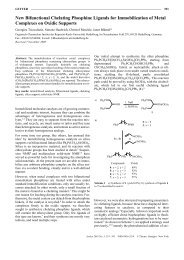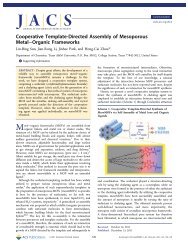Gold Nanoparticles - Department of Chemistry
Gold Nanoparticles - Department of Chemistry
Gold Nanoparticles - Department of Chemistry
You also want an ePaper? Increase the reach of your titles
YUMPU automatically turns print PDFs into web optimized ePapers that Google loves.
Nano Letters PERSPECTIVE<br />
despite constant dosing, gradually starts to decline. 29 Various<br />
mechanisms have been put forward to explain this phenomenon<br />
including insufficient drug compliance, increased drug clearance,<br />
or an increased distribution volume (i.e., a shift from proteinbound<br />
gold to cell-bound gold). 29<br />
Following absorption <strong>of</strong> gold, either from tissues or the<br />
gastrointestinal tract, approximately 95% is bound to albumin<br />
and/or globulin where it can remain within the plasma for several<br />
months. 4,30 <strong>Gold</strong> has also been found within the cellular compartment<br />
<strong>of</strong> blood, primarily in the erythrocyte fraction. 31,32<br />
Here, gold has been shown to be within or attached to the<br />
membranes <strong>of</strong> red blood cells (RBCs), 24,33 with uptake dependent<br />
on either the amount <strong>of</strong> gold available for red cell precursors<br />
in the bone marrow or the gold binding capacity <strong>of</strong> plasma<br />
proteins. 32 Indeed, it has been shown that uptake into RBCs<br />
ceases after 48 h even though there is still considerable gold in the<br />
plasma, presumably as all the gold by this time is tightly bound to<br />
plasma proteins. As gold uptake into RBCs differs among people,<br />
being more pronounced in smokers, 34 this could explain the large<br />
variability in gold distribution seen among patients. <strong>Gold</strong> is<br />
widely distributed throughout the body with organs <strong>of</strong> the<br />
reticuloendothelial system, especially the lymph nodes, having<br />
the greatest affinity for this heavy metal. 16 The liver and bone<br />
marrow have each been shown to account for 25% <strong>of</strong> the total<br />
body gold burden with the skin and bone each accounting for<br />
20%. 23 Furthermore, the exact form <strong>of</strong> gold in these locations<br />
remains unknown although it appears to be inactive as it remains<br />
detectable in tissue samples taken from patients who had been<br />
treatedwithgoldyearsearlier. 35 In general, gold has little<br />
affinity for keratinous tissue, 18 but it can accumulate in the skin<br />
dermis 36,37 during intravenous administration, with negligible<br />
levels recorded when gold is given orally. 28 At very high levels <strong>of</strong><br />
intravenous administration, gold has also been shown to deposit<br />
in the cornea as detected by slit lamp examination. 38<br />
<strong>Gold</strong> Metabolism and Excretion. <strong>Gold</strong> is primarily excreted<br />
in the urine and feces and although the rate <strong>of</strong> excretion varies<br />
considerably from patient to patient, the basic pattern remains<br />
the same. 30,36 Following intramuscular injection <strong>of</strong> gold, it has<br />
been shown that urinary excretion was greatest during the first<br />
day postinjection while fecal excretion was greatest during the<br />
middle <strong>of</strong> the week. 30 Although, the amount <strong>of</strong> gold excreted in<br />
the urine and feces increases as the amount <strong>of</strong> injected gold<br />
increases, the excretion rate was not directly proportional to the<br />
amount injected. 30 The high binding capacity <strong>of</strong> albumin for gold<br />
may explain the slow rate <strong>of</strong> gold clearance throughout the week<br />
following gold injection. When gold is given orally, 85 95% is<br />
excreted in feces and the remaining 5 15% in urine, regardless <strong>of</strong><br />
dose. 27,28 The majority <strong>of</strong> gold recovered in the feces represents<br />
nonabsorbed gold, gold breakdown products, gold shed from<br />
mucosal cells to which it was adsorbed and a minor contribution<br />
from the biliary tract. 24,39 Once gold treatment is established, a<br />
dynamic equilibrium is set up in the body with gold moving<br />
between the blood, body stores, urine, and feces.<br />
<strong>Gold</strong> Toxicity. Any toxicity associated with gold depends on<br />
its oxidation state when given to patients. Metallic gold (gold(0))<br />
is an extremely inert metal which is widely used throughout the<br />
world in both jewellery and prostheses. Indeed, most <strong>of</strong> the human<br />
population has had prolonged dermal contact with gold(0) in the<br />
form <strong>of</strong> jewelry, with only exceptionally rare cases <strong>of</strong> adverse<br />
reactions or allergic contact dermatitis. Furthermore, approximately<br />
half <strong>of</strong> the 1 billion people in the modern industrialized<br />
world carry dental prostheses made <strong>of</strong> gold with relatively few<br />
cases <strong>of</strong> oral lesions being reported despite the close prolonged<br />
contact <strong>of</strong> the metal with the oral mucosa. 6 However, gold(0)<br />
can, in very minute amounts, be converted to gold(I) by amino<br />
acids contained in sweat and saliva which can then be absorbed<br />
through the skin or gingival mucosa and later enter phagocytic<br />
and antigen presenting cells. 40 That notwithstanding, the metabolic<br />
impact <strong>of</strong> this is usually insufficient to evoke clinical<br />
symptoms. 6 Moreover, as gold(0) is readily available, has a very<br />
low toxicity pr<strong>of</strong>ile, and can be made into a consistently small size<br />
and shape, it has been used as a delivery vehicle for gene<br />
therapy. 41 Indeed, microprojectile bombardment <strong>of</strong> cells with<br />
DNA on gold particles has been developed as an effective method<br />
<strong>of</strong> high frequency gene transfer with minimal damage to living<br />
cells. 42 Experiments injecting naked gold beads into the epidermis<br />
<strong>of</strong> pigs, whose skin is an excellent model for human skin,<br />
concluded that apart from acute impact physical effects, which<br />
resulted in mild transient dermal irritation, there were no direct<br />
toxicities or adverse effects on health, survival, clinical chemistry,<br />
or hematology values related to the gold beads. 6<br />
<strong>Gold</strong>(I) is normally used as therapeutic agent in both injectable<br />
and oral preparations. The toxicities surrounding gold(I)<br />
have been primarily understood by examining patients treated<br />
with gold for RA; however frustratingly, serum and urine levels <strong>of</strong><br />
gold have been <strong>of</strong> no value in predicting impending toxicity in<br />
patients. The most common toxicity associated with gold treatment<br />
is skin and mucous membrane hypersensitivity reactions,<br />
with nonspecific pruritic erythematous, macular, and papular<br />
rashes appearing first. Other rarer skin reactions include cheilitis,<br />
eosinophilia, chronic papular eruptions, contact sensitivity, erythema<br />
nodosum, allergic contact purpura, exfoliative dermatitis,<br />
and pityriasis rosea. 6 This diverse range <strong>of</strong> dermal reactions<br />
appears not to depend on the gold concentrations in the skin and<br />
rarely occur in patients who receive less than 250 mg <strong>of</strong> gold<br />
salts. 11 In fact, it is generally regarded that these reactions<br />
represent the balance between the total body burden <strong>of</strong> gold<br />
salts and the patient’s genetic and metabolic makeup. Management<br />
involves the cessation <strong>of</strong> gold therapy with most cases<br />
resolving within 3 months <strong>of</strong> onset depending on their extent and<br />
severity. The most common form <strong>of</strong> gold-induced dermatitis is<br />
nonallergic, since following clearance <strong>of</strong> the original eruption,<br />
patients can be restarted on gold treatment without developing<br />
further dermatitis. 43 In contrast, allergic contact dermatitis occurs<br />
at a lower incidence and represents an immune reactivity to gold<br />
which usually necessitates total cessation <strong>of</strong> gold therapy. 44<br />
Diarrhea is also frequently associated with administration <strong>of</strong> gold<br />
complexes, but with a greater incidence when patients use oral gold<br />
preparations. 45 Less frequently, gold has been associated with<br />
nephrotoxicity as demonstrated by minor and transient proteinuria<br />
in people treated with injectable gold complexes. 3,46 Occasionally,<br />
this may progress to glomerulonephritis with nephritic syndrome<br />
although patients usually recover fully within a few months. 9,47<br />
Hematological abnormalities can also be sometimes produced by<br />
gold complexes and include eosinophilia, thrombocytopenia, 9 and<br />
rarely aplastic anemia probably as a result <strong>of</strong> a direct inhibition <strong>of</strong><br />
myelopoiesis. 48 Several other reports have also mentioned the rare<br />
consequences <strong>of</strong> using gold complexes including entercolitis with<br />
bloody diarrhea, 49,50 diffuse inflammatory lung reactions, 51 and<br />
neurotoxicity. 52 <strong>Gold</strong> therapy is not recommended during<br />
pregnancy, 53 as animal studies have shown it to be teratogenic. 54<br />
Caution is also advised in the puerperium, despite conflicting<br />
reports as to whether significant absorption occurs in the infant,<br />
since gold can also be found in breast milk. 55<br />
C dx.doi.org/10.1021/nl202559p |Nano Lett. XXXX, XXX, 000–000



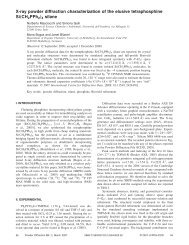
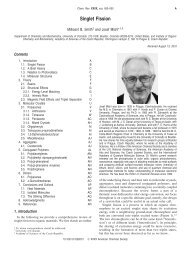
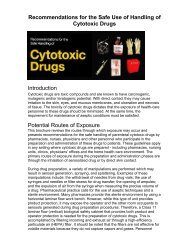
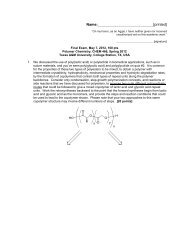

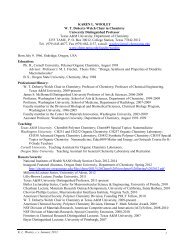
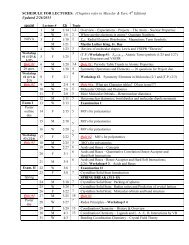
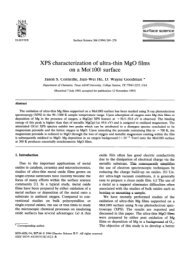
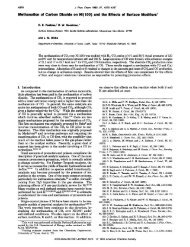
![Radical salts of TTF derivatives with the metal–metal bonded [Re2Cl8]](https://img.yumpu.com/10115211/1/190x253/radical-salts-of-ttf-derivatives-with-the-metal-metal-bonded-re2cl8.jpg?quality=85)


